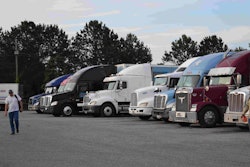The information needs of fleets evolve quickly when they begin to evaluate and deploy vehicles with electric or hybrid powertrains.
Last December, Penske Transportation Solutions (CCJ Top 250, No. 19) began testing two Freightliner eCascadia Class 8 tractors by placing them into service for nightly delivery routes that consist of between 130 and 250 miles with eight to 12 stops.
 With more than 15,000 connected EVs, Geotab is the largest telematics provider in this rapidly growing market segment, said Matt Stevens, the company’s vice president of electric vehicles.
With more than 15,000 connected EVs, Geotab is the largest telematics provider in this rapidly growing market segment, said Matt Stevens, the company’s vice president of electric vehicles.Penske has been using Geotab’s telematics system in the two vehicles. A Geotab Go device connects to the vehicles’ data ports to transmit data to a cloud-based fleet management system.
Bill Combs, director of connected fleet for Penske, said the technology allows the Reading, Pennsylvania-based company to gain insights from remotely monitoring and analyzing operating data of the EVs, such as the state of charge and battery health.
Penske also has Geotab’s Go telematics devices on a portion of its fleet of gas and diesel rental and lease vehicles.
In June 2018, Geotab acquired expertise in EV telematics by purchasing FleetCarma to help fleets accelerate the uptake of EVs. Matt Stevens, founder of FleetCarma, became Geotab’s vice president of electric vehicles. With more than 15,000 connected EVs, Geotab is the largest telematics provider in this rapidly growing market segment, Stevens said.
Fleets that install Geotab’s Go device on fuel-powered vehicles can use the company’s free Electric Vehicle Suitability Assessment (EVSA) tool. The EVSA has reporting that compares a fleet’s vehicle operating data to the universe of telematics data collected by Geotab from EVs with similar operating profiles. The report predicts a fleet’s potential EV energy use, efficiency and range.
As the uptake of EVs continues to grow, telematics providers will be developing new features to monitor data points specific to EVs and to optimize route plans based on vehicle range and operating conditions.
Verizon Connect is planning updates for its fleet management platforms to provide EV-based and mixed fleets a more robust feature set for monitoring data and route planning, said Kevin Aries, the company’s global leader of product success. At present, the platform’s route optimization calculations are based on driver pay and miles.
Trailing indicators
Refrigerated trailers may be the last vehicles to convert from fuel-powered engines to electric motors because of their operating conditions and limited opportunities for charging.
 Thermo King’s telematics system, TracKing, can be used to monitor a wide range of trailer operating conditions.
Thermo King’s telematics system, TracKing, can be used to monitor a wide range of trailer operating conditions.Meanwhile, fleets are using trailer telematics systems to analyze fuel usage, reefer engine run times and equipment utilization to minimize fuel use.
Fleets also use trailer telematics systems to enforce policy compliance in terms of temperature set points and run time (continuous versus start/stop), said Carl Breczinski, Thermo King’s product manager of digital and control solutions for North America.
Thermo King’s trailer telematics platform, TracKing, is installed in more than 40,000 trailers in North American and is offered through the company’s line of Connected Suite products, he said.
Fleets that transport temperature-sensitive loads also have new options to monitor data from reefer trailers that are incorporating solar power technology.
Trailer telematics devices use solar panels to extend battery life and ensure that the devices have power to monitor trailer temperatures, reefer fuel levels and other critical data while the transportation refrigeration unit (TRU) is not running and supplying the power.
Increasingly, TRUs themselves also are using solar panels to save fuel and extend engine life by maintaining the charge of the TRU’s battery, Breczinski said.
The TracKing system has a factory-installed telematics device in Thermo King TRUs that sends temperatures, location and other data to the TracKing website for fleets to monitor. The system also can be deployed on dry van trailers in the aftermarket.
Rather than monitor the website, many fleets integrate TracKing with their fleet management systems using a real-time application programming interface (API). TracKing also has API integrations with third-party telematics systems on trailers to consolidate data from tire pressures, brakes and other components, Breczinski said.
As EVs continue to be tested and deployed in commercial applications, fleets that have the right information to make buying and operating decisions will be able to turn a profit while turning heads.










